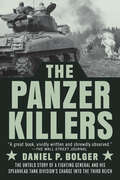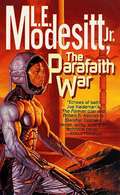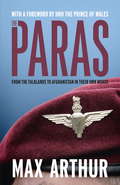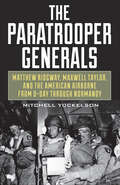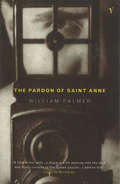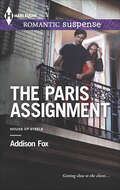- Table View
- List View
The Panzer III: Hitler's Beast of Burden (Images of War)
by Anthony Tucker-JonesThe Panzerkampfwagen III Panzer III was one of the German army's principal tanks of the Second World War, yet its history is often overlooked in comparison to its more famous successors the Panzer IV, Panther and Tiger. Anthony Tucker-Jones, in this volume in the Images of War series, provides a visual account of the tank in over 150 wartime photographs and describes in a concise text its development and operational history. The Panzer III was designed as part of Hitler's re-armarment program in the mid-1930's and played a key role in the German blitzkrieg offensives in Poland, France and the Soviet Union. Although it lacked adequate firepower and could not match more advanced Allied tanks like the T-34, it stayed in service in North Africa and on the Eastern Front and it was still encountered in action in Normandy towards the end of the war. Its reliable chassis was also adapted for assault gun production. In this form, as the Sturmgeschtz III, it took part in the defensive battles fought by the Wehrmacht as it retreated in Italy, France and eastern Europe. Anthony Tucker-Jones's selection of photographs show the Panzer III in every theater of the war and at every stage, and his text gives an insight into the design history and fighting performance of this historic armored vehicle.
The Panzer IV: Hitler's Rock (Images Of War Ser.)
by Anthony Tucker-JonesThe Panzerkampfwagen Mk IV proved to be the one constant in Hitler's Panzerwaffe throughout the Second World War - the German equivalent of the American Sherman and the Soviet T-34. In this companion volume to his best-selling visual histories of the Tiger and Panther tanks, Anthony Tucker-Jones provides a concise account of the Mk IV's design, development and performance in combat. The Mk IV served on every major front, in France, the Balkans, North Africa, the Soviet Union and, at the end of the war, in Germany itself - it was a key weapon in the blitzkrieg attacks launched early in the war and in the later desperate defense of the Reich.Using over 150 rare wartime photographs, plus a selection of specially commissioned color, he describes how the initial design of the Mk IV was modified and refined throughout the course of the conflict to counter the threats posed by ever more formidable Allied tanks and antitank guns on the battlefield. While the Mk IV was never produced in the same numbers as the leading Allied tanks, it was without doubt one of the principal armored vehicles of the Second World War, and Anthony Tucker-Jones's highly illustrated history is the ideal introduction to it.
The Panzer Killers: The Untold Story of a Fighting General and His Spearhead Tank Division's Charge into the Third Reich
by Daniel P. BolgerA general-turned-historian reveals the remarkable battlefield heroics of Major General Maurice Rose, the World War II tank commander whose 3rd Armored Division struck fear into the hearts of Hitler's panzer crews.&“The Panzer Killers is a great book, vividly written and shrewdly observed.&”—The Wall Street JournalTwo months after D-Day, the Allies found themselves in a stalemate in Normandy, having suffered enormous casualties attempting to push through hedgerow country. Troops were spent, and American tankers, lacking the tactics and leadership to deal with the terrain, were losing their spirit. General George Patton and the other top U.S. commanders needed an officer who knew how to break the impasse and roll over the Germans—they needed one man with the grit and the vision to take the war all the way to the Rhine. Patton and his peers selected Maurice Rose.The son of a rabbi, Rose never discussed his Jewish heritage. But his ferocity on the battlefield reflected an inner flame. He led his 3rd Armored Division not from a command post but from the first vehicle in formation, charging headfirst into a fight. He devised innovative tactics, made the most of American weapons, and personally chose the cadre of young officers who drove his division forward. From Normandy to the West Wall, from the Battle of the Bulge to the final charge across Germany, Maurice Rose's deadly division of tanks blasted through enemy lines and pursued the enemy with a remarkable intensity. In The Panzer Killers, Daniel P. Bolger, a retired lieutenant general and Iraq War veteran, offers up a lively, dramatic tale of Rose's heroism. Along the way, Bolger infuses the narrative with fascinating insights that could only come from an author who has commanded tank forces in combat. The result is a unique and masterful story of battlefield leadership, destined to become a classic.
The Paper Birds: A Novel
by Jeanette LynesImagine you have only a pencil and paper, and your puzzle-solving skills to help end the war Gemma Sullivan lands a coveted office job in the summer of 1943, only to discover that she’s been hired to work in a top-secret codebreaking office in an unsuspecting house along the lake in Mimico, Ontario. The ‘Cottage’ – run by the brilliant, eccentric Miss Fearing, who was trained at England’s Bletchley Park – pulls Gemma in with its urgent lure and mystery. But along with this job comes a lifelong oath of secrecy. Gem can’t tell anyone what she does for work, not even her elderly Aunt Wren, who has raised her since the age of three after the tragic death of her parents. Her aunt harbors of a deep love of crosswords and Tarot cards and an equally passionate hatred for war since the death of her own fiancée in WWI. The last thing she'd want for her niece is a job that involves anything to do with the war. The codebreaking is intense, mind-numbing, at times, but as Gem is pulled deeper into wartime intelligence work, she becomes an integral part of the codebreakers’ circle. The Cottage codebreaking unit is small but determined, but in order to be successful, they must learn to work together. But when Gem begins fraternizing with a handsome prisoner at a POW camp nearby - who later disappears - she risks losing everything.The Paper Birds is a WWII love story that reveals the struggles and sacrifices of every day working women during the war and highlights the previously unknown codebreaking work undertaken by women in Canada during the war.
The Para Fitness Guide
by Sam McgrathEvery year getting fit and losing weight is at the top of the list of resolutions but few of us manage to stick to any kind of fitness regime. What you need is a military instructor watching over your exercise programme, helping you out and encouraging you along the way. Unfortunately, we can't supply you with your own personal fitness expert, but this book is the next best thing! In The Para Fitness Guide, Major Sam McGrath of the legendary Parachute Regiment has collected together an inspirational series of exercises which are perfect for anyone. Sam offers advice on how to choose a gym, eat well, prepare for exercise, warm up and how to warm down to reduce the impact of all of those aches and pains. The book also sets out six challenges for readers to aim for as they follow this programme, including a 10-mile race and the grueling Fan Dance around the Brecon Beacons. Recession proof your fitness programme with our accompanying iPhone app; have Major Sam McGrath as your own personal, portable trainer on your mobile device! The updated app now features the Emperor Training programme, pushing your quest for fitness further with weight training. With our help you can be fighting fit in time for your summer hols!
The Parafaith War
by L. E. Modesitt Jr.A standalone military science fiction adventure from, L. E. Modesitt, author of the bestselling Saga of Recluce series, The Parafaith War combines hard science fiction adventure with an insightful examination of the relationship between the sacred and the secular.In the far future among the colonized worlds of the galaxy, there's a war going on between the majority of civilized worlds and a colonial theocracy.Trystin Desoll grows up fighting against religious fanatics and becomes a hero, a first-class pilot, then, amazingly, a spy.What do you do if you're a relatively humane soldier fighting millions of suicidal volunteers on the other side who know that they are utterly right and you are utterly wrong, with no middle ground?Trystin Desoll has a . . . plan.Other Series by L.E. Modesitt, Jr.The Saga of RecluceThe Imager PortfolioThe Corean ChroniclesThe Spellsong CycleThe Ghost BooksThe Ecolitan MatterThe Forever HeroTimegod's WorldOther BooksThe Green ProgressionHammer of DarknessThe Parafaith WarAdiamanteGravity DreamsThe Octagonal RavenArchform: BeautyThe Ethos EffectFlashThe Eternity ArtifactThe Elysium CommissionViewpoints CriticalHazeEmpress of EternityThe One-Eyed ManSolar ExpressAt the Publisher's request, this title is being sold without Digital Rights Management Software (DRM) applied.
The Paras: 'Earth's most elite fighting unit' - Telegraph
by Max Arthur'It should be read by anyone interested not just in military history, but in the history of people, and what they can achieve.' Dan Jarvis Tough, highly adaptable and efficient, the Parachute Regiment has established itself as one of the finest fighting forces in the world. On the occasion of the 75th anniversary of its founding, renowned historian Max Arthur has compiled this enthralling oral history of the modern Parachute Regiment.This unique chronicle is told through the voices of more than a hundred of the soldiers themselves, and of those involved closely with them. Whether in the Falklands, Kosovo, Iraq, Sierra Leone or Afghanistan, the Paras have maintained their reputation for being where the fighting is fiercest and where the odds of survival are often stacked heavily against them.The gripping, visceral first-person narrative makes The Paras stand apart from conventional regimental histories as one of the most remarkable accounts of conflict ever published.
The Paras: 'Earth's most elite fighting unit' - Telegraph
by Max ArthurTough, highly adaptable and efficient, the Parachute Regiment has established itself as one of the finest fighting forces in the world. On the occasion of the 75th anniversary of its founding, renowned historian Max Arthur has compiled this enthralling oral history of the modern Parachute Regiment.This unique chronicle is told through the voices of more than a hundred of the soldiers themselves, and of those involved closely with them. Whether in the Falklands, Kosovo, Iraq, Sierra Leone or Afghanistan, the Paras have maintained their reputation for being where the fighting is fiercest and where the odds of survival are often stacked heavily against them.The gripping, visceral first-person narrative makes The Paras stand apart from conventional regimental histories as one of the most remarkable accounts of conflict ever published.
The Paras: 'Earth's most elite fighting unit' - Telegraph
by Max ArthurThe soldiers of one of the world's most famous fighting forces, the Paras, tell the gripping story of the regiment in their own words.Published to coincide with 75th anniversary of its formation, this is the definitive history of the iconic Parachute Regiment, told through the voices of more than 200 of the soldiers themselves. From the daring raids of World War 2 through Northern Ireland, The Falklands, Bosnia and Afghanistan, the Paras have a reputation for being where the fighting is fiercest and the odds of survival are often stacked heavily against them. The gripping, visceral first person narrative makes this book stand apart from conventional regimental histories.(P)2017 Hodder & Stoughton
The Paratrooper Generals: Matthew Ridgway, Maxwell Taylor, and the American Airborne from D-Day through Normandy
by Mitchell YockelsonA military history detailing the key role two US Army special forces commanders and their infantry divisions played in during the second world war. Generals during World War II usually stayed to the rear, but not Matthew Ridgway and Maxwell Taylor. During D-Day and the Normandy campaign, these commanders of the 82nd &“All-American&” and the 101st &“Screaming Eagle&” Airborne Divisions refused to remain behind the lines and stood shoulder-to-shoulder with their paratroopers in the thick of combat. Jumping into Normandy during the early hours of D-Day, Ridgway and Taylor fought on the ground for six weeks of combat that cost the airborne divisions more than forty percent casualties. The Paratrooper Generals is the first book to explore in depth the significant role these two division commanders played on D-Day, describing the extraordinary courage and leadership they demonstrated throughout the most important American campaign of World War II.
The Paratrooper Training Pocket Manual, 1939–45 (The Pocket Manual Series)
by Chris McNabDuring World War II, it quickly became apparent that the physical and tactical demands placed upon paratroopers required men of exceptional stamina, courage and intelligence. To create these soldiers, levels of training were unusually punishing and protracted, and those who came through to take their &“wings&” were a true elite. The Paratrooper Training Pocket Manual 1939–1945 provides an unusually detailed look into what it took to make a military paratrooper during the Second World War, and how he was then utilized in actions where expected survival might be measured in a matter of days. Using archive material from British, U.S., German and other primary sources—many never before published—this book explains paratrooper theory, training, and practice in detail. The content includes: details of the physical training, instruction in static-line parachute deployment, handling the various types of parachutes and harnesses, landing on dangerous terrain, small-arms handling, airborne deployment of heavier combat equipment, landing in hostile drop zones, tactics in the first minutes of landing, radio comms, and much more. Featuring original manual diagrams and illustrations, plus new introductory text explaining the history and context of airborne warfare, The Paratrooper Training Pocket Manual 1939–1945 provides a detailed insight into the principles and practice of this unique type of combat soldier.
The Pardon Of St Anne
by William PalmerWorking as a news photographer in 30s Berlin, Walther Klinger becomes - by a vicious twist of fate - a society photographer for the new aristocracy of the Nazi party. Walther's complicity makes him increasingly cynical and guilty, so that - for him - the coming of war is almost a relief. In a lonely Brittany farmhouse, just before the Allied invasion, Klinger meets Julia. They begin an affair and, against the background of the horrors and normalities of the Occupation, Walther attempts to make a refuge for himself and Julia. THE PARDON OF ST ANNE is about how he succeeds, triumphantly and tragically.
The Parent Plan Part 1 (36 Hours)
by Paula Detmer Riggs36 Hours SerialAs a devastating summer storm hits Grand Springs, Colorado, the next thirty-six hours will change the town and its residents forever....The Parent Plan Part 1As the rains bring mudslides down the mountain at Devil's Butte, little Vicki Sloane is trapped alone in a dark cave. Anxiously waiting while rescuers search for her are her parents, Karen and Cassidy Sloane.Dr. Karen Sloane is used to being in charge and saving lives at the hospital. But she feels shattered and helpless in the face of this disaster. Her only comfort is Cassidy's strong arms. When he accuses Karen of neglecting Vicki, his anger toward her is as chilling as the cold rain.For rancher Cassidy Sloane, family is the most important thing, and all he ever wanted was to take care of his wife and daughter. But does Karen even need him anymore? She seems to care about her patients more than her family, and now Vicki's been put in danger.Will Vicki's accident bring this loving but strong-willed couple together, or drive them further apart?The story continues in The Parent Plan Parts 2 and 3.
The Parent Plan: Part 2 (36 Hours)
by Paula Detmer Riggs36 Hours SerialAs a devastating summer storm hits Grand Springs, Colorado, the next thirty-six hours will change the town and its residents forever....The Parent Plan Part 2Cassidy has been angry and hostile ever since Vicki's accident, blaming Karen for working at the hospital while Vicki needed her. It's causing a rift in their marriage that gets bigger every day. Karen can't face the loneliness anymore of being with a man too frozen inside to love.Is a separation the only way out? And if Karen and Cassidy try to solve their problems apart, how can they ever get back together?The story concludes in The Parent Plan Part 3.
The Parent Plan: Part 3 (36 Hours)
by Paula Detmer Riggs36 Hours SerialAs a devastating summer storm hits Grand Springs, Colorado, the next thirty-six hours will change the town and its residents forever....The Parent Plan Part 3Vicki's accident the night of the storm deepened the cracks in the already fragile marriage of her parents, Karen and Cassidy Sloane.Cassidy buries the pain of his broken relationship in work on his ranch. As past demons resurface, his bottled-up feelings threaten to explode. He knows he's made mistakes, but is it too late to heal his marriage?Vicki needs a father, and Karen misses the strong, loving man she fell in love with. But if this marriage is going to succeed, Karen will need to help Cassidy learn there is no single way to be a loving family.Don't miss the final book in the 36 Hours serial, You Must Remember This by Marilyn Pappano.
The Paris Agent: A Gripping Tale of Family Secrets
by Kelly RimmerFrom the bestselling author of The Things We Cannot Say and The Warsaw Orphan, Kelly Rimmer—for fans of All the Light We Cannot See and The Tattooist of Auschwitz!A &“MOST ANTICIPATED TITLE&” by Harper's Bazaar B&N Reads BookBub Goodreads Fresh Fiction"The author&’s research has captured the tension that those who lived through that time experienced at deep levels. Kelly Rimmer&’s scenes in both eras are fraught with anxiety, urging the reader to keep turning the page, anxious to learn about each character&’s experiences, right up to the very end." — New York Journal of Books For fans of fast-paced historical thrillers like Our Woman in Moscow and The Rose Code, Kelly Rimmer&’s dramatic new novel follows two female SOE operatives whose lives will be determined by a double agent in their midst. Twenty-five years after the end of the war, Noah Ainsworth is still preoccupied with those perilous, exhilarating years as a British SOE operative in France. A head injury sustained on his final operation has caused frustrating gaps in his memory—in particular about the agent who saved his life during that mission gone wrong, whose real name he never knew, nor whether she even survived the war.Moved by her father&’s frustration, Noah&’s daughter Charlotte begins a search for answers that resurrects the stories of Chloe and Fleur, the code names for two otherwise ordinary women whose lives intersect in 1943 when they&’re called up by the SOE for deployment in France. Taking enormous risks to support the allied troops with very little information or resources, the women have no idea they&’re at the mercy of a double agent among them who's causing chaos within the French circuits, whose efforts will affect the outcome of their lives…and the war.But as Charlotte&’s search for answers bears fruit, overlooked clues come to light about the identity of the double agent—with unsettling hints pointing close to home—and more shocking events are unearthed from the dangerous, dramatic last days of the war that lead to Chloe and Fleur&’s eventual fates.For more by Kelly Rimmer, look for The Things We Cannot Say Before I Let You Go Truths I Never Told You The Warsaw Orphan The German Wife
The Paris Agent: Inspired by true events, an emotionally compelling story of courageous women in World War Two
by Kelly RimmerFrom the bestselling author of The Warsaw Orphan, this emotionally compelling novel is inspired by real-life female WWII agents including Violette Szabo and Diana Rowden, whose incredible stories have never before been brought to readers.Twenty-five years after the end of the year, ageing British SOE operative Noah Ainsworth is reflecting on the secret agent who saved his life when a mission went wrong during his perilous, exhilarating years in occupied France. He never knew her real name, nor whether she survived war. His daughter Charlotte begins a search for answers. What follows is the story of Fleur and Chloe, two otherwise ordinary women who in 1943 are called up by the SOE for deployment in Frances. Taking enormous risks with very little information or resources, the women have no idea they're at the mercy of a double agent within their ranks who's causing chaos.As Charlotte's search for answers continues, new suspicions are raised about the identity of the double agent, with unsettling clues pointing to her father........................................Praise for Kelly Rimmer:'The German Wife is a heart-wrenching, uplifting story about love and family and the choices we make in impossible situations' CHRISTINE WELLS'Once again, Kelly Rimmer has turned my emotions upside down' SALLY HEPWORTH'A fast-paced, emotional and utterly riveting tale of love, loss and the choices we make to protect our families - a must-read' KRISTIN HARMEL'Kelly Rimmer's heart-stopping rendering of the war in Nazi-occupied Poland-of life, resistance, survival, and love-will captivate readers' LISA WINGATE
The Paris Apartment
by Kelly BowenThis heart-wrenching novel about family and war unearths generations of secrets and sacrifices—perfect for fans of The Paris Orphan and The Lost Girls of Paris.2017, London: When Aurelia Leclaire inherits an opulent Paris apartment, she is shocked to discover her grandmother&’s hidden secrets—including a treasure trove of famous art and couture gowns. One obscure painting leads her to Gabriel Seymour, a highly respected art restorer with his own mysterious past. Together they attempt to uncover the truths concealed within the apartment&’s walls. Paris, 1942: The Germans may occupy the City of Lights, but glamorous Estelle Allard flourishes in a world separate from the hardships of war. Yet when the Nazis come for her friends, Estelle doesn&’t hesitate to help those she holds dear, no matter the cost. As she works against the forces intent on destroying her loved ones, she can&’t know that her actions will have ramifications for generations to come.Set seventy-five years apart, against a perilous and a prosperous Paris, both Estelle and Lia must unearth hidden courage as they navigate the dangers of a changing world, altering history—and their family&’s futures—forever.
The Paris Assignment (House of Steele #1)
by Addison Fox"I didn't hire you to be my bodyguard."It was obviously an inside job-and security expert Campbell Steele figured he'd have to get very close to his new client, CEO Abigail McBane, to uncover the traitor. But when an electronic blip led to a bullet, he had to move fast....Suddenly the commitment-shy expert is posing as Abby's lover and jetting off to a conference in Paris. The city of lovers should be the perfect cover to trap the enemy. As the stakes keep rising, they soon realize it isn't just her company the traitor wants, but Abby herself. And Campbell isn't about to lose what he's claimed as his own....
The Paris Bookseller
by Kerri MaherINSPIRED BY THE WOMAN WHO FOUNDED SHAKESPEARE AND COMPANY'A vivid evocation of the famous female-owned Parisian bookshop... Kerri Maher writes a love letter to books, bookstores and booklovers everywhere' Kate Quinn, author of The Alice Network'I was completely enthralled' Natasha Lester, author of The Paris SecretThe captivating story of a trailblazing young woman who fought against incredible odds to bring one of the most important books of the twentieth century to the world. For readers of The Paris Library and The Paris Wife.PARIS, 1919.Young, bookish Sylvia Beach knows there is no greater city in the world than Paris. But when she opens an English-language bookshop on the bohemian Left Bank, Sylvia can't yet know she is making history.Many leading writers of the day, from Ernest Hemingway to Gertrude Stein, consider Shakespeare and Company a second home. Here some of the most profound literary friendships blossom - and none more so than between James Joyce and Sylvia herself.When Joyce's controversial novel Ulysses is banned, Sylvia determines to publish it through Shakespeare and Company. But the success and notoriety of publishing the most infamous book of the century comes at deep personal cost as Sylvia risks ruin, reputation and her heart in the name of the life-changing power of books...---'A compelling and fascinating look at the world-changing mavericks who bonded, bickered and triumphed in the realm of literature' Nuala O'Connor'A compelling portrait of a remarkable woman, who steps from the pages in all her charm, courage and vulnerability' Gill Paul'Intelligent, fierce and filled with reverence for a fascinating epoch in literary history... a delight for readers and writers' Whitney Scharer, author of The Age of Light'Lulls you into an interwar Parisian dream where love - be it romantic, friendly or even for a book - can be found on a quirky little street in the 6th' Kaia Alderson, author of Sisters in Arms
The Paris Bookseller: A sweeping story of love, friendship and betrayal in bohemian 1920s Paris
by Kerri MaherINSPIRED BY THE WOMAN WHO FOUNDED SHAKESPEARE AND COMPANY'A vivid evocation of the famous female-owned Parisian bookshop... Kerri Maher writes a love letter to books, bookstores and booklovers everywhere' Kate Quinn, author of The Alice Network'I was completely enthralled' Natasha Lester, author of The Paris SecretThe captivating story of a trailblazing young woman who fought against incredible odds to bring one of the most important books of the twentieth century to the world. For readers of The Paris Library and The Paris Wife.PARIS, 1919.Young, bookish Sylvia Beach knows there is no greater city in the world than Paris. But when she opens an English-language bookshop on the bohemian Left Bank, Sylvia can't yet know she is making history.Many leading writers of the day, from Ernest Hemingway to Gertrude Stein, consider Shakespeare and Company a second home. Here some of the most profound literary friendships blossom - and none more so than between James Joyce and Sylvia herself.When Joyce's controversial novel Ulysses is banned, Sylvia determines to publish it through Shakespeare and Company. But the success and notoriety of publishing the most infamous book of the century comes at deep personal cost as Sylvia risks ruin, reputation and her heart in the name of the life-changing power of books...---'A compelling and fascinating look at the world-changing mavericks who bonded, bickered and triumphed in the realm of literature' Nuala O'Connor'A compelling portrait of a remarkable woman, who steps from the pages in all her charm, courage and vulnerability' Gill Paul'Intelligent, fierce and filled with reverence for a fascinating epoch in literary history... a delight for readers and writers' Whitney Scharer, author of The Age of Light'Lulls you into an interwar Parisian dream where love - be it romantic, friendly or even for a book - can be found on a quirky little street in the 6th' Kaia Alderson, author of Sisters in Arms(P) 2022 Headline Publishing Group Ltd
The Paris Code: A breathtakingly beautiful story of love and sacrifice set in wartime Paris
by Natasha LesterA breathtakingly beautiful story of love and sacrifice set in wartime Paris, from the bestselling author of The Paris SecretA strong woman. A dangerous city. A fight for freedom . . .1928. Eighteen-year-old Marie-Madeleine is not the kind of woman who goes through life sitting down, something her new husband can attest. Her unconventionalities - rally car driving, flying planes and dabbling in intelligence work for the French government - earn her a reputation, but she knows who she is at heart: an adventurer.Ten years later, as Europe teeters on the brink of war, a chance encounter with a mysterious man codenamed Navarre turns Marie-Madeleine's life upside down. Recruited to help build a resistance network known only as Alliance, she conceals her identity - and gender - as she navigates a perilous double-life away from her children and the man she loves. Capture and death are only ever a heartbeat away.But when the resistance finds themselves without a leader, Marie-Madeleine steps into the role, heedless of the many men who doubt her abilities. Will she, a young mother from Paris, help turn the tide of war?Internationally bestselling author Natasha Lester passionately brings to life the true story of one of history's unsung heroes: Marie-Madeleine Fourcade, the only woman to lead a resistance network in WWII France. Her story is one of epic love, tragic loss and magnificent leadership.
The Paris Code: A breathtakingly beautiful story of love and sacrifice set in wartime Paris
by Natasha LesterA breathtaking historical women's fiction novel full of heart-stopping intrigue and romance, following the true story of Marie-Madeleine Fourcade, the only woman to lead a WWII Resistance network.
The Paris Daughter
by Kristin HarmelInstant New York Times bestseller! &“A gorgeous, gut-wrenching&” (Kate Quinn, New York Times bestselling author) historical novel about two mothers facing unthinkable choices as the Nazis invade France—from the New York Times bestselling author Kristin Harmel. Paris, 1939: Young mothers Elise and Juliette become fast friends the day they meet in the beautiful Bois de Boulogne. Though there is a shadow of war creeping across Europe, neither woman suspects that their lives are about to irrevocably change. When Elise becomes a target of the German occupation, she entrusts Juliette with the most precious thing in her life—her young daughter, playmate to Juliette&’s own little girl. But nowhere is safe in war, not even a quiet little bookshop like Juliette&’s Librairie des Rêves, and, when a bomb falls on their neighborhood, Juliette&’s world is destroyed along with it. When the war finally ends, Elise returns to reunite with her daughter, only to find her friend&’s bookstore reduced to rubble—and Juliette nowhere to be found. What happened to her daughter in those last, terrible moments? Juliette has seemingly vanished without a trace, taking all the answers with her. Elise&’s desperate search leads her to New York—and to Juliette—one final, fateful time. A sweeping celebration of resilience, motherhood, and love, The Paris Daughter is &“historical fiction at its best&” (Sadeqa Johnson, New York Times bestselling author).
The Paris Daughter: Two mothers. Two daughters. Two families torn apart
by Kristin Harmel'An unmissable reading treat' Lancashire Evening PostA heartwrenching and evocative wartime novel, perfect for fans of Santa Montefiore, Rachel Hore and Lucinda Riley.Two mothers. Two daughters. Two families torn apart forever.Paris, 1939. Elise and Juliette are certain nothing can come between them. So, when war breaks out and Elise is forced to flee, she entrusts Juliette with her daughter, playmate to Juliette's own little girl.More than a year later, with the war finally ending, Elise returns to reunite with her daughter, only to find her friend's bookstore reduced to rubble – and Juliette nowhere to be found. What happened to Mathilde in those last terrible moments? Juliette has seemingly vanished without a trace, taking all the answers with her. Elise's desperate search leads her to New York – and to Juliette – one final, fateful time.The Paris Daughter is a story about mothers and daughters, the way loss transforms us, and the roads we find to beginning anew in the face of impossible odds.PRAISE FOR KRISTIN HARMEL:'Kristin Harmel is firmly in the top echelon of WW2 storytellers' HEATHER MORRIS'A master storyteller' SANTA MONTEFIORE


